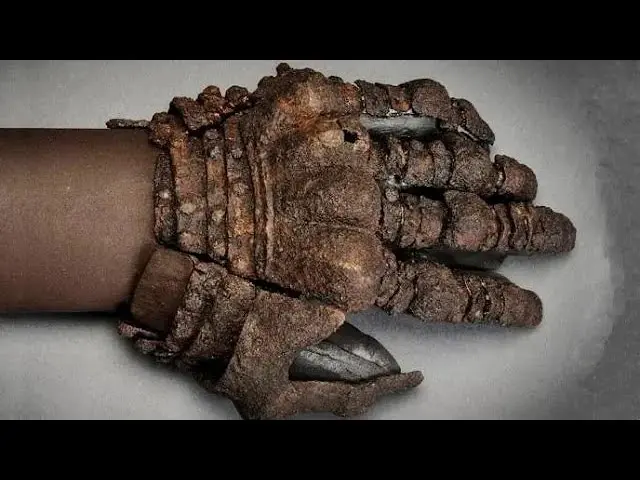
1. Prehistoric Tools in West Sussex, England: A Glimpse into Early Human Ancestors
The discovery of prehistoric tools in West Sussex, England, represents a significant leap in understanding our early ancestors. Dating back half a million years, the site in Boxgrove revealed evidence of Homo Heidelbergensis, a species potentially pivotal in the human evolutionary tree. These ancestors were not only skilled in crafting tools from horse bones but also in using them for butchery, as evidenced by the flint flakes found near horse remains. This discovery not only highlights their tool-making abilities but also suggests complex social structures, as the quantity and nature of these artifacts imply collaboration among multiple individuals. These finds offer a rare window into the daily lives and social interactions of one of our earliest known ancestors, raising intriguing questions about the evolution of human socialization and tool use.
2. The Mysterious Druid Stone of Nottinghamshire, England
In the tranquil landscape of Nottinghamshire, England, stands the enigmatic Druid Stone, a natural rock formation shrouded in mystery due to a man-made passageway cut through its center. This intriguing feature fuels speculation about its creators and purpose, especially since there are no significant ancient structures nearby. Named for its supposed druidical connections, the stone and its passageway have been linked to pagan rituals, possibly aligning with the sunrise on May Day and the Gaelic festival of Beltane. Local legends even suggest that passing through the Druid Stone could cure illnesses. Despite its uncertain origins, the Druid Stone remains a testament to the rich tapestry of England’s prehistoric and early historic landscape, blending natural wonder with human ingenuity and spiritual beliefs.
3. The Burial Box of Mariam: A Connection to Biblical Stories
The discovery of a 2,000-year-old burial box in Jerusalem adds a tangible dimension to the narratives of the New Testament. The box, initially seized by tomb raiders in the 1990s, was later authenticated by Israeli scholars, revealing an inscription that links it to Mariam, the daughter of Yeshua, son of Caiaphas, the priest. This priest, Yosf Bar Caiaphas, is a significant figure in the biblical account of Jesus Christ’s crucifixion. The authenticity of the inscription and the box’s age lend credence to the historical accuracy of the New Testament stories. For believers and historians alike, this artifact offers a fascinating convergence of religious text and archaeological evidence, bridging the gap between faith and historical inquiry.
4. Battle of Visby Artifacts: Medieval Warfare Frozen in Time
The Battle of Visby, a fierce conflict in 1361 on Gotland Island, Sweden, between Danish invaders and local villagers, left a significant archaeological footprint. The battlefield, unearthed in 1905, revealed an extraordinary collection of medieval warfare artifacts. Preserved for nearly 700 years, these relics include chain mail armor, spears, knives, gauntlets, and other items of battle wear, offering an unparalleled glimpse into medieval combat. The artifacts, now housed in the Gotland Museum, attract thousands of visitors annually. This collection is not only a reminder of the brutality of medieval warfare but also serves as a valuable educational resource, providing insights into the design, craftsmanship, and use of medieval weaponry and armor.
Related: Top 10 Archaeological Discoveries People Found By Accident
5. Gordon Taylor’s Field Discovery in Humber, England: A Treasure Trove of History
The discovery in a field near Humber, England, by amateur archaeologist Gordon Taylor, unraveled a remarkable cache of historical artifacts, spanning a significant period of English history. Beginning in 1962 and continuing for 17 years, Taylor’s dedication to exploring this site culminated in the unearthing of over 250 items. These artifacts included spearheads, scissors, jewelry, and notably, a 1,000-year-old human skull. Intriguingly, while most of the items date back to around 450 AD, the skull’s origins remain a mystery. The collection’s highlight, the jewelry, adorned with runic inscriptions from the early Germanic alphabet, offers valuable insights into the history of writing in the British Isles. Taylor’s findings, which fetched $50,000 at auction in 2020, represent a significant contribution to our understanding of early English history.
6. Ancient Jewelry Tribute to Jupiter Daknis in Turkey
At the site of the ancient Temple of Jupiter Daknis in Diche, Turkey, archaeologists unearthed an extraordinary collection of over 600 amulets and seals. These artifacts, dating between 2700 and 2400 years old, were likely offerings to Jupiter Daknis, a Roman weather god. The range of materials, from glass to quartz and stone, reflects the diverse social and economic statuses of the individuals who left them. Intriguingly, some of these seals had holes, suggesting they were worn around the neck, possibly to identify or protect the wearer. The engravings on these amulets, depicting various scenes and animals, add another layer of mystery, as their purpose—whether decorative or symbolic—remains a matter of speculation. This discovery not only sheds light on Roman religious practices but also on the cultural and artistic expressions of the era.
7. Volcanic Glass Phallus-Shaped Tools in Papua New Guinea: A Ceremonial Artifact
The accidental discovery of phallus-shaped tools in Papua New Guinea, made from volcanic black glass, provides a unique glimpse into the ceremonial practices of ancient Melanesian people. Estimated to be around 6,000 years old, these delicate artifacts were found by bulldozer operators at a site in Aide. Dr. Robin Torrance of the Australian Museum, who studied the tools, suggests that their thin construction indicates a ceremonial rather than practical use. Their shape points to a possible connection with fertility rituals. This discovery not only highlights the artistic and cultural practices of one of the Pacific region’s most ancient civilizations but also enriches our understanding of the symbolic use of objects in early human societies.
8. The Tel Carasa Wand: A 9,000-Year-Old Staff with Human Faces
In the ancient site of Tel Carasa in Syria, archaeologists unearthed a fascinating artifact – a wand or staff, adorned with human faces on both sides, crafted from narwhal tusk. Dating back 9,000 years, this staff is a significant find as it represents one of the earliest known naturalistic depictions of human faces in this region. Its proximity to an ancient graveyard suggests a possible role in funeral ceremonies. This artifact offers a rare insight into the artistic expression and cultural practices of early humans in this area. The discovery of traces of barley, chickpeas, and herds of goats nearby also indicates that the creators of this staff might have been among the world’s first farmers, adding a vital chapter to the story of human civilization.
9. The Pera Civilization’s Legacy in Mesoamerica: Unraveling the Unknown
The 2014 discovery of copper and bronze rattles in Mesoamerica by a team from Colorado State University has cast new light on the enigmatic Pera civilization, a warrior race that resisted the Aztecs for centuries. These rattles, found in tombs alongside ceramic vessels, are believed to be grave goods, a tradition common in many ancient cultures. Remarkably, these rattles still function, defying the passage of time. The discovery also included over 20,000 architectural features, including a central platform and pyramid-shaped temples, revealing a complex and sophisticated society. This find is pivotal in understanding the Pera civilization, whose language and culture remain largely mysterious, providing a rare glimpse into their societal structure and cultural practices.
10. Byzantine Wooden Notebooks: The Ancestors of Modern Tablets
Discovered in a shipwreck at Theodosius’ Port in Tenic, Turkey, in 2014, these ancient Byzantine wooden notebooks offer a fascinating insight into early technological ingenuity. Dating back 1,200 years, these relics are akin to modern-day tablets. The well-preserved example found likely belonged to the ship’s captain, comprising a note-taking tablet with wax and a layer for weight calculation. This multifunctional device served both as a tool for recording information and as an assay balance for weighing precious items. This ancient gadget highlights the remarkable foresight of Byzantine craftsmen, foreshadowing today’s multifaceted digital devices and underlining the continuity of human innovation through the ages.
11. Ancient Ayahuasca Usage in the Bolivian Andes
The 2019 discovery in the Bolivian Andes of a thousand-year-old leather pouch, made from three fox snouts and containing hallucinogenic substances, unveils a long history of ayahuasca use. This pouch, found in a remote cave 13,000 feet above sea level, contained harmine and dimethyltryptamine, key compounds in ayahuasca, along with traces of cocaine. The mixture’s potency suggests preparation by a knowledgeable shaman, likely from the Tiwanaku civilization. This find not only confirms the ancient use of psychoactive plants for spiritual or ritual purposes but also offers a direct link to the practices of a civilization known for its profound cultural and spiritual complexity.
12. Barabar Caves of India: An Ancient Acoustic Marvel
The Barabar Caves in India, carved approximately 2,300 years ago, represent an architectural and acoustic wonder of the ancient world. These caves, polished to amplify echo effects, were likely used for religious purposes, enhancing the sound of chants, hymns, and prayers. The Lomas Rishi Cave, notable for containing India’s oldest known Chaitya arch, suggests that these caves were a significant center for early Hindu and Buddhist practices. The extraordinary acoustic properties of these caves indicate a deliberate design choice, akin to the acoustic engineering found in modern cathedrals and concert halls. This discovery not only sheds light on the architectural prowess of ancient Indian civilizations but also on their understanding of sound and its role in spiritual and communal gatherings.



